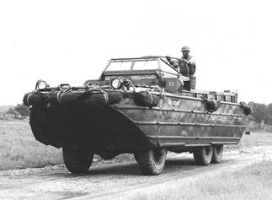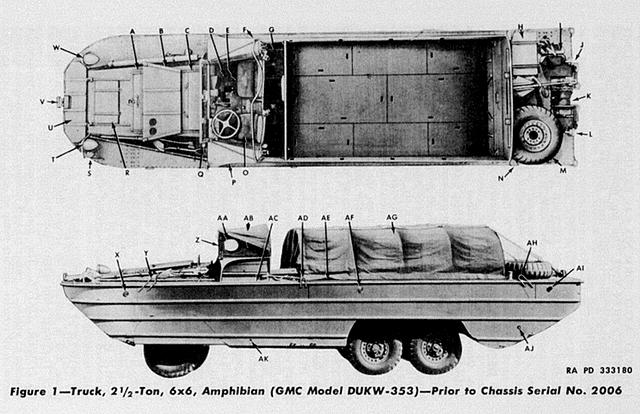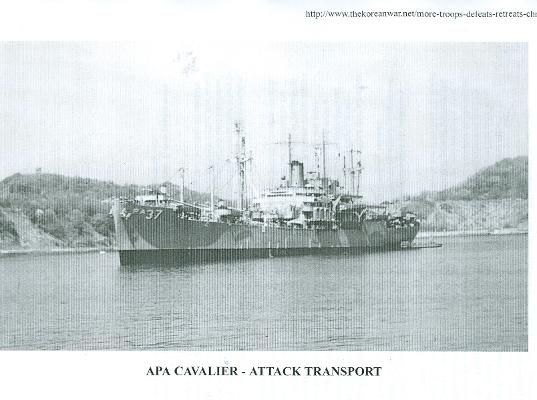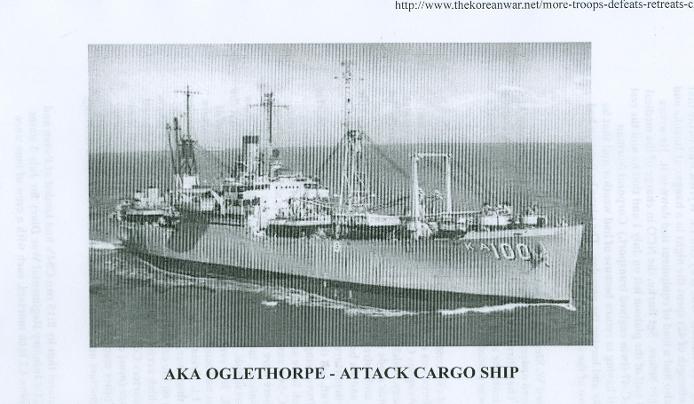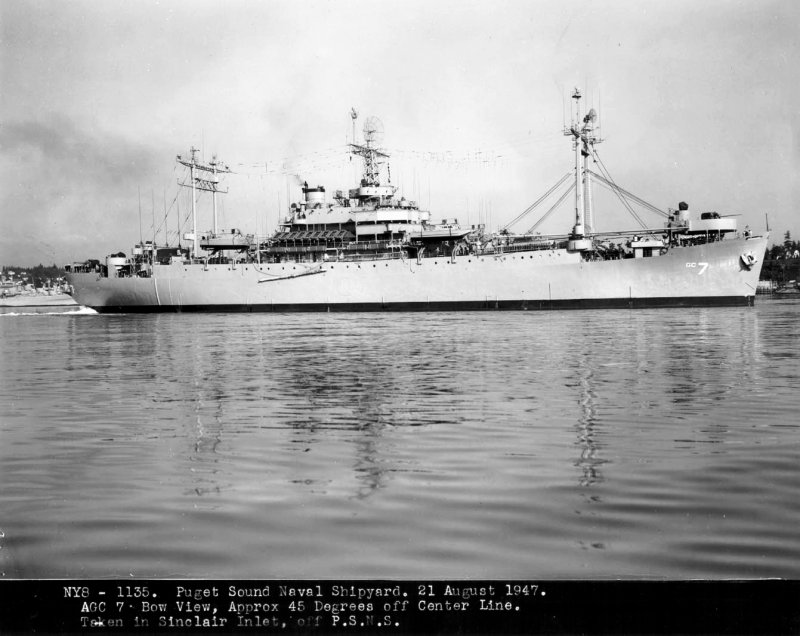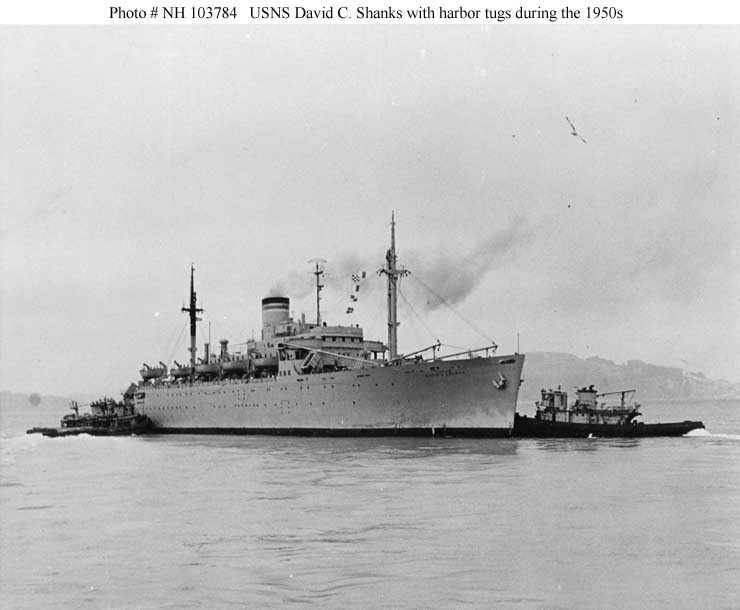FIRST CAVALRY DIVISION (INFANTRY)
JUNE 25: The strength of the First Cavalry Division on this date was ten thousand three hundred seventy four (10,374). Requisitions were submitted to bring the Division up to the authorized strength of twelve thousand five hundred ten (12,510).
The 1st Battalion of the 7th Cavalry Regiment departed Camp Wood, Tokyo, Japan for Tachikawa Air Force Base, Tokyo, Japan for Air Transportability Training, but upon their arrival, no planes were available because of the Korean situation. The second Battalion had just returned from the Camp McNair Training area on Mount Fuji where squad and platoon firing exercises were complete4d, and the Battalion had made detailed plans to move from McKnight Barracks, Tokyo to Camp King, at Omiya, located 18 miles northeast of Camp Drake, however that move was cancelled.
26 JUNE: The Seventh Cavalry Regiment Regiment was placed on a seven day week duty schedule.
27 JUNE: The Eighth Army ordered the Division to transfer 15 Officers and 732 Enlisted men to the 24th Infantry Division, Combat effectiveness was reduced as thirty percent of those enlisted men were of the top four grades. and were combat veterans of the war in the Pacific. Seventh Cavalry Training to date had not consisted of any Battalion or Regimental phases and only a limited amount of Company phases; however the companies were in fair shape. The Regiment comprised an organization typical of an Infantry except that it lacked one battalion and a tank company. Actually it was a two Battalion Regiment with two rifle company battalions. Each company was short at least 20 percent of its authorized strength.
JULY 1: The Division transferred 732 enlisted men and 15 officers to the 24th Infantry Division. All transfers were to begin on this date. The 5th Cavalry Regiment furnished 166 enlisted men, the 7th Cavalry Regiment furnished 168 enlisted men, the 8th Cavalry Regiment furnished 165 men.
JULY 2: Division Artillery transferred 120 enlisted men to the 24th Infantry Division. The total of these is only 609 enlisted men. I have been unable to find where the other 123 enlisted men and 15 officers came from. Possibly they came from Division Headquarters. The 7th Cavalry Regiment received training in cargo net climbing and some debarking from LCVP's (Landing Vehicle Personnel). The training was hurried and sketchy
JULY 3: Company A, 71st Heavy Tank Battalion with 125 enlisted men and 6 officers left Camp Chigasaki at 8 AM for Camp McGill, arriving there at 9AM. JULY 5. The 71st Tank Battalion was alerted to move to Korea. Upon arrival the Battalion was to be attached to the 24th Infantry Division, however, the battalion will revert to control of the First Cavalry Division upon its arrival in Korea. . The 99th Field Artillery Battalion left for Camp Magill for special amphibious training. The 5th and 8th Cavalry Regiments were receiving priority in receipt of personnel and supplies, so it appeared that higher headquarters did not intend to use the 7th along with its sister 5th and 8th Regiments.
JULY 6: The Eighth Army Amphibious Training Center at Camp McGill was attached to the Division in order to expedite planning and training for "Operation Bluehearts". Planing and training was supervised by Colonel Edward Forney, Unites States Marine Corps, utilizing personnel from the Amphibious Training School and a number of Marine Corps personnel who were experts in amphibious operations. Those plans called for moving the entire Division in three lifts, landing at Inchon, Korea. The training primarily consisted of practicing debarking from transport ships into landing craft by using mock-ups constructed at Camp McGill and which had been in use since February 1950. The 7th Cavalry Regiment prepared for storage and shipping of supplies and equipment.
JULY 7: Elements of the 13th and 43d Engineer Battalions and the 55th Treadway Bridge Company were attached to the Division. Companies "B" and "D", 8th Engineer Combat Battalion moved to Camp McGill for Shore Party training. The 7th Cavalry Regiment was alerted for amphibious operations in Korea. It must be noted that the personnel of this Regiment had received NO amphibious training except that mentioned on July 2.
JULY 8: The 64th Field Artillery Battalion arrived at Camp Zama and was attached to the Division. The 7th Cavalry Regiment was alerted for amphibious operations in Korea.
JULY 9: The 5th Cavalry Regimental Combat Team began preparing for embarkation. At sometime after this date and July 14th, the destination for the amphibious landing was changed due to the unexpectedly rapid advance of the North Korean forces. "Operation Bluehearts" (the landing was to be at Inchon on the West coast, just a few miles from Seoul) was carried out except that the destination was changed from Inchon on the west coast to Pohang-dong, much further south and on the east coast. The 7th Cavalry Regiment began planning for an amphibious operation. The Regiment would have 4 ships, the USNS Shanks, USNS Ainsworth, one Japanese operated LST (Landig Ship Tank) and one Japanese operated freighter. No 2 1/2 ton trucks could be loaded on the Shanks or the Ainsworth,so they had to be loaded on the LST and the freighter.
JULY 10: According to the Division War Diary for this date, the 1st Battalion of the 8th Cavalry Regimental Combat Team and Battery "A" of the 92d AAA (AW) Battalion assembled for embarkation. The 77th Field Artillery Battalion completed a three day orientation in amphibious operations in preparation for moving onto Landing Ship Tank's (LST"S) and moved to Opama , south of Yokohama. Four LST"s were each loaded with 10,000 pounds of ammunition. DUKW's of the 8082d Amphibious Truck Company then ferried 105mm howitzers to those same LST's. See photo and description of DUKW's below. The 7th Regiment began getting priority on requisitions. Weapons received were in poor condition. This was especially true of machine guns and 75mm Recoilless Rifles. Motor vehicles were also in poor shape, The Motor Officer estimated that at least 75 percent of them were not Combat Serviceable. Ammunition was not available for the 2.36 Rocket Launchers and NO 57mm Recoiless Rifles were available.
DUKW'S WERE A MODIFICATION OF THE STANDARD 2 1/2 TON ARMY 6x6 TRUCK. THE DRIVER HAD CONTROLS TO CHANGE THE AIR PRESSURE IN THE TIRES - LOW FOR DRIVING IN SAND OR OTHER SOFT SURFACES AND HIGH FOR DRIVING ON HARD SURFACES.
JULY 11: The 64th Field Artillery Battalion was relieved from attachment to the Division and was to be attached to the 24th Infantry Division immediately upon its arrival in Korea.
JULY 12: First Cavalry units began loading on ships for movement of the First Lift to Korea. A group consisting of Lt. Colonel Holley (Division Engineer Officer), Major Morrison (Division Intelligence Officer), Major McCord (Division Air Officer), Captain Perrin (Division Signal Corps Photographer), Captain Ware (Division Signal Officer), Captain McNary and 1st Lieutenant Breslin from the 8th Cavalry Regiment and Master Sergeant Broderick from the 5th Cavalry Regiment flew to Korea to reconnoiter the landing area. The 5th Cavalry Regiment began loading aboard an AKA, an APA (see photos below and three LST"s (Landing Ship Tank). The Commanding Officer of the 7th Cavalry Regiment assembled all officers for an orientation lecture and the Operations Officer presented the operational plans. It was announced that Lieutenant General Walton (Commander of the Eighth Army in Japan) would assume command of all U.S. Forces in Korea. His headquarters was to be designated "EUSAK (Eighth United States Army in Korea), located in Taegu.
JULY 13: Elements of the 8th Cav RCT sailed from the North Dock area of Yokohama. Division Artillery units, less the 82d FA Bn sailed from Opama. Requisitions were submitted to bring the Division up to authorized strength plus covering for expected losses in the first three days of combat. Total requested: 128 Officers and 2,892 Enlisted Men. Elements of the 5th Cav RCT were loading aboard the APA Cavalier, AKA Oglethorpe (photos below) and 3 LST's The Division had received 1,450 replacements out of the 126 officers and 2,892 enlisted men needed. LST QO31 and the Japanese freighter Shinshi were made available for transporting the 7th Cavalry Regiment to Korea.
JULY 14: The remaining elements of the Division Headquarters forward elements boarded the USNS Mt.McKinley. A command post was established, working closely with Navy and Marine Corps personnel. Loading of the 5th Cav RCT continued. Loading of the 7th Cav RCT and other elements of the second lift commenced. The Division Advance Party flew from Japan to Korea.
The 7th Cavalry Regiment began loading on the LST and thee Japanese freighter Shinshi early. Forty 2 1/2 ton trucks and their trailers, Seven 1/4 ton vehicles, one trailer and a 3/4 ton maintenance vehicle , their drivers and Captain Smith, Lieutenant Crider and Warrant Officer Martin boarded ship, taking rations and water for 14 days. Two medics boarded at the same time. Ten 2 1/2 ton trucks were loaded on the Shinshi, their drivers, an interpreter and Lieutenant Nelson boarded at the same time with sufficient rations and water. Both ships were completely loaded before the end of the day.
COMMAND SHIP - USNS MT. MCKINLEY
JULY 15: The Command Ship Mt. McKinley and the balance of the first lift sailed for Korea. Composition of the first lift was as follows: A. 1st Cavalry Division (Infantry) commanded by Major General Gay. A Medical Detachment commanded by Lt. Colonel Barmand; 8th Engineer (C) Battalion; Detachment of the 15th QM (Quartermaster) Company; 15th Medical Bn. (Battalion); 8063d Surgical Team; 13th Signal Battalion; Detachment 17th Ordinance Maintenance Company; 545th MP (Military Police) Co. Regimental Anglice Detachment. B. At 1730 hours RCT 5 commanded by Colonel Rohsenberger; 5th Cav (Infantry); Company "A" 8th Engineer (C) Bn.; Detachment 13th Signal Co.; Battalion Anglice Detachment, IPW Team 5 (Interrogation, Prisoner of War); Artillery Liaison Party and Forward Observers (FO's) from 61st FA Bn. C. RCT 8 commanded by Colonel Palmer; 8th Cav (Infantry); Company "C", 8th Engineer C (Combat) Bn.; Detachment 13th Signal Co.; Bn Anglice Detachment; IPW Team 8; Artillery Liaison Party and Forward Observers's from 99th FA Bn. D. 16th Reconnaisance Company commanded by Captain Harvey. E. Division Artillery commanded by Brigadier General Palmer; 61st FA Bn; 77th FA Bn; 99th FA Bn; Battery "A" 92d AAA AW Bn.; 8062d Amphibious Truck Co with 66 DUKW's). F. Division Shore Party commanded by Lieutenant Colonel Gibbons; Company "B", 8th Engineer (C) Bn; Company "D", 8th Engineer (C) Bn.; Eighth Army ATC, attached; 14th Engr Band, atchd; Company "D", 13th Engineer (C) Bn. attached; Co "A" 43d Engineer Bn. attached; Two (2) Signal Detachments - 13th Signal; Company; Two (2) Ordinance Detachments - 27th Ordinance Maintenance Company; Two (2) MP Detachments 545th MP Company; Two (2) Clearing Platoons, 15th Medical Battalion; Two (2) Detachments, 15th QM (Quartermaster) Company; Detachment of Naval Beach Group One; Detachment 8062d Amphibious Truck Company with 13 DUKW's. Two Japanese operated ships loaded with most of the 2 1/2 ton trucks of the 7th Cavalry Regiment sailed for Korea from Yokohama where they would meet the 2d lift. The rest of their equipment was loaded aboard the USNS Shanks and USNS Ainsworth. The LST and freighter Shinshi sailed simultaneously loading the remaining 7th Cavalry Regiment vehicles at piers 5 and 6 at Yokohama where the Shanks and Ainsworth were docked. At 1400 hours all remaining vehicles at Camp Drake and McNight Barracks were sent to be loaded on the Shanks and Ainsworth.
JULY 15: The Mt. McKinley received predictions of typhoons and heavy seas beginning with 48 hours. Loading of the 2d lift aboard the USNS Shanks, USNS Ainsworth and USNS E.D. Patrick began. Photos appear below. the 7th Cav reported they were short the following items: anti-tank mines, 4.2 HE (High Explosive) mortar ammunition, 57mm recoilless rifles, 3.5 inch rocket launchers (bazookas)and ammunition and 9 pairs of binoculars. Loading of the Shanks was completed by 0130 and the Ainsworth by 0500.
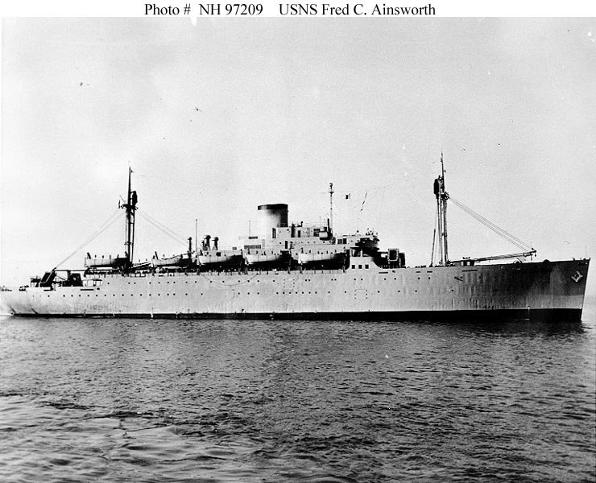
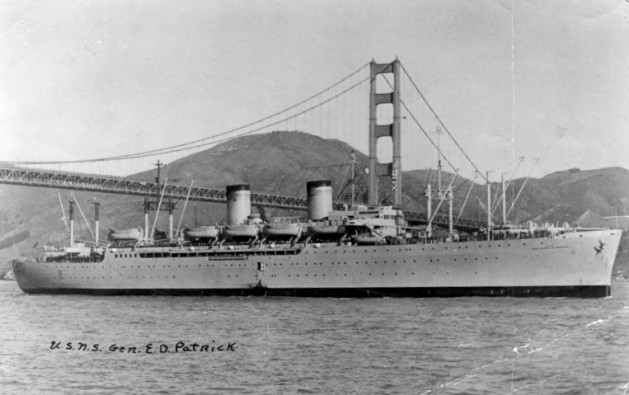
JULY 17: The second lift of the 1st Cavalry Division finished loading and sailed from Yokohama Harbor with Brigadier General Allen, the Assistant Division Commander, in command. After a conference with General Walker, the Division Advance Party sent a message that speedy unloading was imperative!
At 1000 hours the 7th Cavalry Regiment began loading the First Battalion on the Ainsworth, with the Heavy Mortar Company boarding last beginning and 1200 hours. Simultaneously the 2nd Battalion began loading on the Shanks with the last unit starting at 1200 hours. All troops were completely loaded by 1445. The Ainsworth left the dock at 1720 hours and the Shanks left at 1730 hours. Both ships anchored in the bay until 2000 hours, at which time the convoy andthe two ships pulled away from the piers at 2000 hours at which time the convoy, consisting pf the Patrick,Ainsworth, Shanks and a Navy Corvette took the southerly route for Korea.
JULY: 18 The first lift of "Operation Bluehearts" arrived at Pohang-dong with H-Hour (the hour at which landing was scheduled to commence) designated at 7:15 AM Forward elements of the 8th RCT were ashore by 6:10 AM. All elements were bivouac area just outside of Pohang-dong by 5:00 PM. Lead elements of the 5th RCT began landing at 6:30 AM and by early afternoon were assembled about 5 miles west of Pohang-dong. They were alerted for movement to Yong-dok the following day. Unloading of supplies and equipment continued for the rest of the day and throughout the night. Division Artillery began unloading at 7:30 AM. The forward echelon Division Headquarters established a Command Post (CP) by 2:30 PM near the airstrip at Yonil, south of Pohang-dong.
JULY 18 and 19. Briefing was presented outlining the fact that the 7th Cavalry Regiment would land on July 20 and would be the Division Reserve. The First Battalion was to move to Yong-dock and relieve elements of the 27th Regiment. Typhoons "Gracie" and "Flossie" came along, creating rough seas and a long journey.
JULY 19: A few LST's were still unloading ammunition and supplies when a message was received from the Navy that unloading should be expedited as a Typhoon Helene was approaching and all ships had to be moved to a location which sheltered them. Unloading was completed by 5:00 PM. General Walker, EUSAK (Eighth U.S. Army in Korea) Commander, directed that the Division be concentrated in the Yongdok-Kumchon area southeast of Taejon. Beginning at noon July 19, the 5th RCT began moving from the Pohang-Dong area to the Kwan-Ni area, halfway across the peninsula to relieve the 21st Infantry Regiment of the 24th Infantry Division, then in Taejon. About that time, plans changed and they were forced to move to the vicinity of Yang-Dang.
JULY 20: The last elements of the 5th Cav RCT arrived at Kwan-ni at 9:00 AM. Liaison was established with the 24th Division. At 11:00 PM reports were received that the 19th and 34th Regiments of the 24th Division were withdrawing to the east. This had been self-evident all day as 5th Cav units had difficulty advancing to the west due to the clogging of roads by 24th Division units all day. The plan was to relieve a unit of the 24th Infantry Division near Taejon. The 8th Cav RCT (1215 men) began leaving Pohang-dong by trains and trucks, arriving in the vicinity of Yongdong at 6:00 PM. (They were short three 75mm and eighteen 57mm recoilless rifles, all 3.5 inch rocket launchers, sniperscopes, ANGR/C6 and ANGR/C9 (radio sets). The 7th Cavalry Regiment was enroute to Korea by a southerly route, avoiding the straits and the numerous typhoons in the area.
A message from 8th Army stated that Company "A" of the 79th Tank Bn would immediately revert to control of the Division and that the Division would receive 158 3.5 inch rocket launchers from the 24th Division when the Division relieved them. General Gay was also informed that he would not get any of the non-commissioned officers transferred to the 24th Division and that as soon as the 64th FA Bn arrived in Korea, it would revert to the control of the 25th Infantry Division.
The second lift, 7th RCT and other assorted units, were scheduled to debark at D plus 2, but two typhoons were reported in the area so the convoy reduced speed and headed out to the open sea because it was not safe to enter the straits between Honshu and Kyushu because of the high winds and seas. Debarkation was to be accomplished by dividing personnel into boat groups.
JULY 21: The Division Command Post was set up at 0651 hours at Pohang-dong. The remainder of the 1st lift, including Division HQ moved to the vicinity of Kumchon. The Division was given the mission of securing Yong-dong, coordinating with the Korean I Corps and the 25th Infantry Division to the right.
JULY 22: The second lift arrived Pohan-dong by LST and debarked at 1600 hours and moved to a bivouac area about 2 1/2 miles west of Pohang-Dong. The 64th Field Artillery Battalion reverted to Eighth Army control. Upon landing, the 7th Cavalry Regiment was moved to a bivouac area about 4 to 6 miles out of town. the 1st Battalion plus 1 platoon of the Heavy Mortar Company and 1 Medical platoon relieved the 1st Battalion, 35th Infantry Regiment. The remainder of the Regiment is to move by rail and motor convoy to the visinity of Taegu-Kumchon, a distance of ablut 100 miles. The Division received a requisition from the 5th Cavalry Regiment for one hundred seventy five (175) enlisted men. The Second Battalion of the 5th Cavalry Regiment moved to a position three miles east of Yang-Dang and the First Battalion moved to Hwang-gan astride the Yang-Dang Hwang-gan road with the dual mission of preventing encirclement of the 8h Cavalry Regiment in positions west of Yang-Dang. Pressure on the 8th Cavalry became so heavy that the 1st Battalion, 5th Cavalry was displaced southwest of Yang-Dang to arrest the enemy drive, and was forced to withdraw through the 2nd Battalion blocking positions southeast of Hwang-gan and the 2nd Battalion withdrew just in the rear of the 1st Battalion. The enemy was still moving east. The 1st Battalion surprised an enemy battalion and inflicted severe casualties.
JULY 23: Order of movement from the Pohang-dong area is as follows: 5th Cavalry Regiment, 8th Cavalry Regiment, Division Artillery and the 7th Cavalry Regiment less the 1st Battalion.
JULY 24:
JULY 27: The 7th Cavalry RCT requested a replacement Medical Officer and other replacements. No action was taken due to lack of any replacements.
JULY 28: The Division Forward Command Post moved to a position about two (2) miles northwest of Kumchon, Korea. The Division Rear moved to Waegwon, Korea, approximately twenty (20) miles southeast of Kumchon, Korea. A policy on evacuating Korean Nationals was received. All evacuees in the division area are to move Northwest of Sonsan to the hills This move is to be directed by the Chief of Police of Kumsan, assisted by three (3) Korean National Police assigned to the Division for that purpose.All food in Kumchon is being moved toward Waegwan ay any means of trasnprtation available. The 8063rd Army Mobile Surgical Hospital reverted to Eighth Army control. Four prisoners have been captured as of this date.
Beginning on 29 July, the 5th Cavalry Regiment was withdrawn east. The 1st Battalion was placed in blocking positions in the vicinity of Chirye to prevent the enemy in this area from cutting off the Main Supply Route (MSR) in the vicinity of Kumchon. The 2nd Battalion withdrew to Kwani, then to Kumchon. As the month ended, the 5th Cavalry assumed blocking positions in Kumchon to permit an orderly withdrawal of UN Forces along the MSR eastward.
JULY 31: Division Command Post moved to Waegwan from Kumchon at 1930 hours. Distance of the move was about 20 mnies. The 2nd Battalion, 34th Infantry with 288 personnel, was attached to this Division. The 15th Replacement Company was designated to handle the rehabilitation of patients returning to duty. For the period 22 July thru 31 July,27 officers,1 Warrant Officer and 30 enlisted men were processed.
AUGUST 1: the enemy threatened to sever the division MSR (Main Supply Route) Southeast of Kumchon by infiltration and envelopment with his numerically superior forces. This forced the Division to withdraw to new defensive positions extendinbg for 40 miles along the East bank of the Naktong River in the vicinity of Waegwan (1138-1453). Troopers from the First Battalion operating in the Chirye area were confronted by the usual dawn attack.and were forced to withdraw toward Kumchon. They established several road blocks from Kumchon southeast to Waegwan. All service and clerical personnel were formed into rfile elements to support Easy and Fox Companies.
AUGUST 2. From 30 July thru 2 August, the Division received 197 officer replacements and hospital returnees, 6 Warrant Officer replacements and hospital returnes and 4171 enlisted replacements and hospital returnees. Duriong that same period, the Division sustained 1,503 battle and 619 non-battle casualties and lost 36 officers and men through administrative changes. authorized officers is 943, assigned 851, Warrant Officers authorized 164, assigned 74, authorized enlisted men: 17,807, assigned 14,546. Beginning at about 0355 hours Fox Company began receiving heavy mortar fire from the West. Immediately after ceasing mortar fire, the enemy launched a very strong attack on Easy Company, forcing them off the high ground and toward the East. The enemy then launched attacks designed to sever the Kumchon-Waegwan Road. A rapidly organized force consisting of Regimental Headquarters and Service Company men attacked and drove the North Korean force back about two thousand yards. North Korean forces were heavily reinforced and stopped the advance of that group. Our losses were three killed and nine wounded. At 1400 hours the 7th Cav Regiment began a retrograde movement from the Kumchon area to a point four miles north of Waegwan. The 7th Cav Regiment was assigned the mission of the withdrawal of the Division with During the afternoon the First Cavalry Division ordered a general withdrawal with the First Battalion, Fifth Cavalry forming the rear guard. The Commander and Executive officer of the 2nd Battalion who were wounded. Major Allen assumed command.
AUGUST 3: By 0600, the 5th Cav Regiment had moved to coordinates 1143.2-1450.5, the 7th Cav Regiment had moved to coordinates 1126.5-1462.0 and the 8th Cav Regiment had noved to coordinates 1128.8-1461.1. Division Artillery was at coordinates 1128.5-1461.3. The 8th Engineer Battalion had moved to coordinates 1130-1461.1 and the 2d Battalion 8th Cav Regt had moved to coordinates 112638-1444. Company A, 71st Tank Bn moved to coordinates 1138-1454.5. Railway and highway bridges leading into and out of Kumchon on the North, South and East were demolished. Additionally railroad and highway bridges across the Naktong at Waegwan were prepared for demolition. An ammunition train of nine cars, abandoned by the 25th Division at Kumi (1130-1469) was moved into Waegwan at 030430 by troops of the 8th Engineer Battalion The Division was preparing to occupy positions on the East side of the Naktong River with regiments abreast. The 5th Cav Regiment was on the right, the 7th Cav was on the left and the 8th Cav Regiment was in the center. The Regiments were successful in helping elements of the 25th Infantry Division to withdraw through their positions. The regiments spent the day in reinforcing defensive positions. The 16th Recon Company was assigned the duty of the Naktong River and screening the passage of varoius groups crossing it.There was no strong enemy contact and none was expected immediately due to the successful withdrawal of the Division. The Division Intelligence Section (G-2) reported that the enemy was assembling his forces at Kumchon and south of Kumchon at grid squares 1100-1450. South Korean police estimated that force to be about a regiment. The Division Artillery took up positions but firing missions were rare due to the successful disengagement from the enemy. The 24th Infantry Division was located to the left and the 1st ROK Division was on the right. Lt. Colonel Mahoney assumed command of the 2d Battalion, 5th Cav Regiment due to the loss of its original Commander, Lt. Colonel Clifford on 2 August.
The 5th Regiment was only at about 70 percent of authorized strength, which made it extremely difficult to form effective defensive lines. For example the Second Battalion was assigned to cover 18,000 yards, or over ten miles the east side of the river north and south of Waegwan. After a week of planning, arrangements were completed which allowed Field Artillery units to cover the entire front. Lt. Colonel William J. Mahoney arrived and assumed command of the 2d Battalion from Major Allen. There were no attacks by the North Koreans on this day.
AUGUST 4: 5th Cavalry Regiment: Another day with no North Korean attacks. More detailed coordination with flanking units was begun. The First ROK Division was on the right (North) and the 8th Cavalry Regiment was on the left (South). The I&R Platoon was ordered to cross the river to make contact with the enemy. The bridges crossing the river at Waegwan were destroyed to prevent their use by the enemy. The Regimental commander, Colonel Rohsenberger was reassigned to Headquarters, 8th Army, being replaced by Colonel Marcel G. Crombez. Lt. Colonel Margan B. Heasley was placed in commend of the 2st Battalion.
AUGUST 5 thru 8; 5th Cavalry Regiment. Aggressive and extensive patrolling during this period of time. Patrol reports indicated that the Reds had sustained heavy losses and were regrouping before resuming the attack. During this period, the enemy artillery was being used, hitting a command post twice during the period. The communists were putting heavy pressure on the First Rok Division to the extent of threatening the entire right flank.
AUGUST 9: An enemy element of unknown strength passed through the widely deployed Able Company and proceeded eastward. Able and Charlie Companies reestablished the river line and Baker Company was given the mission of clearing the Battalion area one thousand yards east of the river. Elements of the7th Cavalry Regiment were attached to the 1st Battalion for the purpose of clearing out the rear areas. This group located the enemy force and drove then up Hill 268, also known as Triangulation Hill located about three thousand yards east of the Naktong River By this tine, daylight was almost gone and the Red ()First) Battalion consolidated its position for the night, closing all exits from the hill. General Walton Walker, Eighth Army Commander and General Hobart Gay, 1s Cavalry Division Commander visited the Regimental Command Post.
AUGUST 10: Shortly after dawn, Baker Company of the 5th Cavalry Regiment, assisted by elements from the 7th and 8th Cavalry Regiments, began clearing the Battalion area. The temperature was almost unbearable and the terrain rugged and steep. This action resulted in one officer and six enlisted men were recommended for the award of the Silver Star for bravery. A visitor to the Command Post was Sir Randolph Churchill, son of Winston Churchill, wartime Prime Minister of England, who was assigned to Korea to cover the war news for the London Daily Telegraph.
AUGUST 11: For the third straight day, the main effort of the 5th Cavalry Regiment was directed at Hill 288. After Baker Company had cleard out the last pocket of resistance, it headed rearward to assist in the elimination of enemy forces on Triangulation Hill. Their attack was preceded by intense artillery fire and also supported by all available tanks. VY (proximity shells which exploded at a predetermined height above ground) shells were used exploded in air to reach enemy personnel dug in in foxholes. Artillery fire covered the East slope, Mortar fire covered the crest and the west side of the hill was covered by fire from tanks. Tomorrow all of these elements would again blanket the hill and the Red (First) Battalion would close in for the kill.
AUGUST 12: Fifth Cavalry Regiment. Before dawn, approximately 100 North Korean soldiers attempted to leave Hill 268 to rejoin their main force across the Naktong River. They were immediately driven back. At this point, an attempt was made by the Psychological Warfare Team to avoid further bloodshed. As a result a few of those men surrendered. Capture of Hill 268 was completed by 1700 hours. Attacks by our aircraft on the hill were precluded due the a large build-up of enemy forces in front of the ROK zone of responsibility. The South Korean Minister of Defense visited the Command Post. Up until three days ago, the Naktong was only fordable in a few places. However during the past three days the river level dropped three feet, creating numerous places where in could be forded on foot. It began to rain this evening, thus alleviating the threat of numerous fording places.
AUGUST 13: Foifth Cavalry Regiment. Communist forces began probing the defense line by sending two platoons across the river in Able and Charlie Company's areas. Artillery fire quickly put an end to that attempt. Later in the day, the I&R Platoon, assisted by members of Headquarters Company, made a survey of Triangulation Hill. Based on the equipment and bodies found, it was concluded that the 7h North Korean Regiment (equivalent in strength to a U.S. Battalion) had been completely exterminated. AT 2100 hours "Kelly's Boys" (a South Korean guerilla unit) and members of the I&R Platoon went to the West side of the river for more information about the enemy.
AUGUST 14: 5th Cavalry Regiment. All during the day fire fights could be heard in the ROK zone of responsibility . The intensity increased. Finally North Korean forces were observed massing in front of George Company, deployed on the Regimental right flank. This was followed by small arms fire at 1125, The remainder of Fox Company, down to 80 men from its normally authorized strength of about 200, was directed to protect the rear and right flank of a similarly depleted George Company. North Korean radio announced that August 15th was North Korean "Independence Day" and that Taegu would be taken in honor of the event.
AUGUST 15:5th Cavalry Regiment. George Company was put in motion by approximately 50 soldiers accompanied by two tanks at 0400 hours advancing south on the river road in front of their position at Hill 303. An additional column was observed moving to their rear. Shortly thereafter, Fox Company began receiving small arms fire. Four and one half hours later at 0833 hours, George Company and the supporting platoon of mortar men from How company was completely surrounded. In the meantime, Fox Company withdrew to avoid being surrounded. The Battalion Commander sent Baker Company and a platoon of tanks to open an escape route. As soon as a gap was opened, it was almost immediately closed by additional North Korean troops.
16 AUGUST. Able Company was sent to join the rescuing group. A massed attack by the enemy stalled the attack 500 yards short of their objective In the meantime, B-29s dumped bombs on the enemy west of the Naktong. To assess the damage, a patrol was sent across the river, but the enemy was so numerous that they could not cross.
17 August. Easy Company was sent to join the rescuing force at 0400 hours. By 1445 hours it appeared that there would be little opposition,but at 1745 hours the I&R Platoon began receiving small arms fire . By 0920 an estimated 500 enemy were in place and were still being reinforced. By 1030, that force was estimated to over 700. To the right, ROK's were attacked. Division was asked for assistance at 1130 hours. Beginning at 1400 hours thru 1430 hours, there would be air strikes on the enemy, immediately followed by artillery fire. The Air Force used Napalm, 500 pound bombs and rocket fire on the enemy. By 1530, the rescuing units were advancing up the hill. At 1639 hours, they came upon the Mortar Platoon from How Company. Five were wounded and thirty-six dead. The mortar men had their hands tied behind their backs and had been lined up and sprayed with a burp gun. Four North Koreans were captured, one of those was the one firing the burp gun and another was the officer who had ordered the execution. At this point the North Koreans were fleeing north in a disorganized mass.
19-25 AUGUST. Now that pressure had slackened, the primary concern was to consolidating and strongly entrenching the retaken positions. Receipt of 300 replacements helped replace some of the losses. The enemy continued his attack on the ROK forces, who were gradually being forced back. There were rumors that the long awaited 3rd Battalion would arrive shortly.
26 AUGUST. In an effort to locate enemy positions on the West side of the Naktong, two platoons of Able Company and the 70th Heavy "Tank Battalion exposed themselves on the road from Waegwan south to Taegu,however the enemy did not take the bait, thus were not exposed to our artillery fire. The most welcome Third Battalion arrived. They went by train to Sindong and marched forward till they reached the rear of the Regimental Command Post. It's Headquarters and Mortar Company continued on after dark. The new battalion had 36 officers and 600 enlisted men. The Commanding Officer is Lt. Colonel Edgar J. Treacy, Jr.
27 AIGIST. The new battalion was scheduled to relieve the 8th Cavalry Regiment of its responsibility of covering fourteen thousand yards of the front on 30 August.
28 AUGUST. Relief of the 8th Cavalry began at dusk. Patrols from the 1st and 2nd Battalions visited the west side of the river and did not encounter any North Korean troops.
29 AUGUST. Relief of the 8th Cavalry was accomplished by the Third Battalion before 1100 hours. Since the Battalion had no mortar support, a composite platoon made up by members of the First and Second Battalions. At about the same time, the Second Infantry Division relieved the 7th Cavalry Regiment who were deployed at the First Cavalry Division's left flank. The 2d Division's 23rd Regiment occupied the ground immediately to the left of the 3rd Battalion.
30 AUGUST. The 3rd Battalion was augmented by a platoon of tanks from the 70th Heavy Tank Battalion, a section of 155mm howitzers fron the 82d Field Artillery Battalion and Charlie Battery of the 61st Field Artillery Battalion.
31 AUGUST. The 7th Cavalry Regiment was sent to soften up Hill 518. The Fifth Cavalry Regiment was to furnish 4.2 Mortar fire when requested. Division reported that the North Koreans had penetrated the 23d Infantry Regimental area during the night and that an all out attack was imminent. A new policy resulted in the assignment of 197 South Korean troops being assigned to the 5th Cavalry. The problem was that they spoke no English and had been hastily trained.
1 SEPTEMBER. Plans were made to accomplish the reduction of Hill 518 (1142.1-1461.5) West to include hill 346 (1139.8-1461.0) to gain control of all terrain South of line (1138-1463.8)(1143-1462.6) ((1144.3-1463.3) with5). subsequent attack to line (1150-1465) (1152.5-1462). As a result, the 8th Cav Regt advanced to positions generally along the line (1147-1464.4) (1148-1465)((1149.5-1465.5)(1151-1464). The 5th and 7th Cav Regts reported no advances. The 3d Battalion, 23d Infantry Regt (atchd) to the Division, reported an attempt to penetrate in the vicinity of (1145-1431.2) by an unknown number of the enemy, which was repelled. Enemy mortars and artillery were active in the 23d Infantry Battalion and 5th 7th and 8th Cav Regts. which suffered about 80 casualties. Company B, 8th Engineer Battalion attempted to erect barbed wire emplacements in fronto f the 7th Cav Regt but were forced to withdraw due to heavy enemy mortar fire. Fire from Artillery, tanks and self-propelled weapons accounted for the death of 190 of the enemy. The 27th British Infantry Brigade with a strength of 72 officers and 1,459 enlisted men was attached to the Division. Division reported that enemy units on its front are: 1st, 2d, 3d, 10th, 13th and 18th Rifle Divisions and elements of the 105th Armored Division.
2 SEPTEMBER 1950: The Air Force flew strikes of 4 flights fo F-51's who dropped 24 napalm bombs and strafed targets on the ridge and north side of the hill. That strike was followed by another air strike, by F-80's after which artillery from the 77th Field Artillery Bn, 2 batteries of the 9th FA Bn, 1 battery of the 61st FA Bn and one platoon of howitzers from B Battery of the 82d FA Bn. After all this, the7th Cav commenced an assault in Hill 805 a 0900. By 1007 hours the 1st Battalion, 7th Cav moved toward the first phase line as one tank from Task Force Blue opened up to the right front in support of the attack. At 0940 hours the enemy attacked G Company, 8th Cav Regt but were driven off, however the positions of the 2d Battalion, 8th Cav Regt were subject to heavy mortar fire for the rest of the day. At 1022 hours the Commanding Officer of the 1st Bn reported that company F was giving strong machine gun support to the 1st Battalion. At 1029 hours the attack by the 1st Bn was halted momentarily by an unscheduled attack on Hill 518 by four F-80's. By 1055 hours the Air Force had shifted the attack from Hill 518 and the 1st Battalion continued its attack. At this time, 40 to 50 enemy were spotted moving across the Company I front and were taken under fire, resulting in the death of about 15 of them. At 1320 hours the 1st Battalion reported that they were held up at the 2d phase line by intense machine gun and mortar fire from positions on Hill 490 (1143.2-1464.9) and requested permission to shift Co. A around to attack from the North and Northwest while two companies would attack from the front. The shift of Company A was granted but the 3rd Battalion was to attack from company I's position in a northwesterly direction for Hill 490 later that afternoon. At 1615 hours the 1st Battalion withdrew to regroup and then resumed the attack at 1700 hours. At 1715 hours, after smoking hills to the left front, the 3d Battalion advanced through Company I's position Northwest toward Hill 490 and the 1st Battalion continued its attack on Hill 508. The Operations Officer of the 199th North Korean Regiment was captured and he stated that a full scale attack would begin at dusk. At 1830 hours the advance of the 1st Battalion was halted by heavy machine gun fire from the Northeast side of Hill 518. The Third Battalion reported that Hills 490 and 518 would bE assaulted simultaneously at 1850. The Battalion advanced slowly against heavy small arms, automatic and mortar fire. The 3d Battalion advanced to within 200 yards of the summit of Hill 508 and the 1st Battalion had been stopped near the top of Hill 490. Heavy enemy artillery and 120mm mortar fire fell throughout the Regimental sector. All communication lines were severed. As heavy as it was, the enemy fire appeared to be random and not directed. The reported attck began as scheduled and by 2300 hours, G company had been pushed off hill 448 and F Companies positions were overrun. E Company on the right flank was not attacked very heavily and retained its position while F and G companies were reorganizing. The Division Commander directed that all support personnel (clerks, cooks, mechanics, etc) were to be formed into provisional rifle companies. The 8th Cav was directed to occupy Hill 490. L Company, (reinforced) jumped off and took the hill without any opposition. The remainder of the 3d Bn, 8th Cav was dispersed on the high ground astride the road north of Tabu-dong. A Task-Infantry Task force consisting of I Company and the 2d Platoon of B Company, 70th Tank Battalion was established and moved northeast to block the enemy's thrust toward Tabu-dong.
